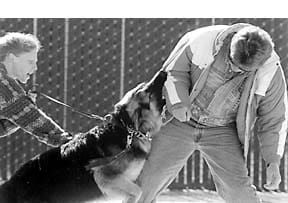[Updated January 10, 2019]
Not far below the furry surface of your favorite domestic canine companion lurks a mind surprisingly similar to that of its ancestor and current-day cousin, the wolf. We have stretched and molded the dog’s plastic genetic material to create hundreds of widely diverse breeds – from the tiny Chihuahua to the giant St. Bernard – all to serve our whims. But our dogs’ behaviors and instincts to this day closely mirror those chosen by natural selection to ensure the wolf’s survival some 10,000 to 15,000 years ago, when the wild canine was first invited to share the warmth and protection of the fires in our ancestors’ caves.
The genetics that have enabled the dog to become “man’s best friend” come as both a blessing and a curse. The instincts that drive the behaviors we love in our canine companions are the same ones that make us tear our hair out. For example, the desire to be a member of a social group, or pack, is what makes the dog so amenable to family life and training. It is this same social instinct that in some dogs triggers incredibly destructive “separation anxiety” behaviors when a dog is left alone, behaviors that include non-stop barking and howling, inappropriate urination and defecation, chewing, and self-destructive escape attempts.
When their behaviors and instincts are understood and properly directed, our dogs are well-adjusted, cherished family members. The millions of dogs that are abandoned at animal shelters in the U.S. every year are tragic testimony to how often we fail to do this. Let’s look at how we can prevent this from happening to your dog.

Dog trainers commonly hear complaints about dogs that bite, attack other dogs, jump up, bark, chase cats, cars, or joggers, are shy, or don’t come when called. All these activities have a basis in normal, instinctive, survival-based canine behavior. They occur in spite of the owner’s training efforts because the dog is rewarded by them in some way.
Fortunately, each behavior can be modified, either by figuring out how to make the desired behavior more rewarding than the undesirable one, or by managing the dog so he doesn’t have an opportunity to exhibit the inappropriate behavior. Traditional training methods have often relied on human logic to teach dogs how to behave, by punishing the dog for “bad” behavior. But in the minds of our dogs, behavior is neither good nor bad; they are just doing what dogs do, driven by instinct and governed by the consequences of their actions. “Good” behavior is learned behavior. They learn more quickly, effectively, and happily if we focus on rewarding the “right” behaviors, and preventing, or to the extent possible, ignoring, the “wrong” ones.
Start Training Your Dog Early
Early management and training is the best approach, since it’s easier to prevent an undesirable behavior than it is to correct it. For this reason, more and more dog trainers offer classes for puppies as young as 10 weeks. Trainers used to recommend waiting until a dog was six months old to start training classes, in part because of the widespread use of “choke chains,” which can damage the soft cartilage of a puppy’s throat. Now that positive-based training is more widely accepted and available (using a standard flat buckle collar or head collar, and rewards and praise instead of leash-jerk corrections), there is no reason to wait. Owners can take advantage of a puppy’s critical socialization period to teach good behaviors.
The socialization period is a time when puppies in the wild have to learn quickly in order to survive. During the same critical period, domestic puppies learn which behaviors are acceptable to their human pack, which are rewarding, and which things are safe. While some veterinarians still counsel keeping a dog isolated at home until it is fully vaccinated by age four to six months, enlightened animal-care professionals recognize that there is far greater risk to our dogs’ lives (through euthanasia at an animal shelter) if they do not learn to be well-socialized and well-behaved during this critical learning period. Many veterinarians now strongly encourage their clients to pursue puppy classes and other controlled socializing activities as long as the pups have received at least two vaccinations and the owner keeps up with the necessary schedule of puppy shots.
Genetically Shy Dogs
Shyness can be genetic, it can result from lack of socialization, or it can be a combination of the two. While the wolf puppy that takes a “no fear” attitude doesn’t live long, neither does a wild pup who is so afraid of his own shadow that he doesn’t leave the den long enough to find adequate food to eat. Reasoned caution is a good survival skill for all dogs, wild and domestic. But because domestic dogs don’t face the life-threatening forces that wild ones do, genetically shy dogs can and do survive to reproduce, especially when assisted by irresponsible breeders and puppy mills.
While all puppies need to be properly socialized (even the bold ones), it is even more imperative to socialize the shy puppy. Left to his own devices, his timid behavior will intensify and he will grow up to be fearful, neurotic, and dangerous.
With these little guys, the flight response is so strong that it is important to be patient. Let the pup initiate contact with strange people or objects and reward each contact with a tasty treat. Don’t force the pup. Forced contact will aggravate the fear/flight response and make the shyness worse. But don’t coddle him, either. Coddling rewards and encourages fear behavior. Be gentle, patient, matter-of-fact, and upbeat about helping him understand and accept the big, scary world.
Always Train A Reliable Recall
Puppies, wild or domestic, naturally stay close to other pack members. Again, it’s a survival thing; the puppy that wanders away ends up as hawk food. Our eight-week-old puppies usually come running when we call them because they are very dependent and want to be near us more than anything else in the world. We soon believe that they have learned to come when we call them. When they get older and more independent, and start to explore the world on their own, they no longer come when we call. We are convinced that they are being stubborn, ignoring us on purpose.
In fact, they never learned to come when called. Now, if they get reprimanded when they do come back (for not coming when they were called) they are even less likely to come the next time they are called, since they have learned that the consequence for coming is punishment, not reward.
In order to teach a reliable “come”, we capitalize on the dog’s desire to be near us and the instinct to seek rewards. When your pup is a baby and comes to you easily, be sure to reward with treats and praise every time. Never punish “come!” If you have to correct for something (like getting in the garbage), don’t call her – go to the pup to administer the mild correction. If she doesn’t come to you when you need her to, resist the urge to chase after her. She’ll think “chase the dog” is a wonderful game. Instead, turn and run away, doing something to get her attention – like making excited, high-pitched noises, squeaking a squeaky toy, or bouncing a ball. Teaching her to “chase” you engages her prey drive and takes advantage of her instinct to stay with the pack (you) and her strong desire to be a part of exciting pack activities.
Bite Inhibition
Of all unwanted behaviors, biting is the least socially acceptable to humans, and the one that most often results in a death sentence for the dog. Yet biting is a totally natural behavior for dogs, both wild and domestic. Wolf puppies and adults bite each other in play and in warning. Very rarely do they bite each other in order to do serious damage. It is vital to the survival of the pack that all members be strong and healthy. It makes no sense for pack members to engage in fierce battles that might result in serious injury. As pups, they learn the importance of bite inhibition by playing with each other. When a pup bites a littermate too hard, the victim yelps loudly and may refuse to play for a while. Thus the biter learns that the fun of play ends when he bites too hard. Over the first five months of his life, he learns to control the strength of his bite. If he doesn’t have this opportunity, it is much more difficult for him to learn to use his mouth gently later.

Enter the human. We routinely take the domestic puppy away from his siblings at six to eight weeks, sometimes earlier, effectively eliminating the pup’s opportunity to learn bite inhibition. No wonder we end up with shark-puppies who chomp down on our hands, sometimes even drawing blood with their needle-sharp teeth!
Responsible breeders won’t release their puppies to new homes until they are at least eight, sometimes ten weeks of age or older. Progressive animal shelters put litters of young pups in foster homes so they can grow and learn from each other, rather than placing them too early. Yet, trusting in the myth that “the earlier you get a pup the more she will bond with you,” uneducated dog owners clamor for the six-week-old puppy (or younger). Unethical breeders, uneducated backyard breeders and shelters that lack adequate foster programs may oblige.
Even if adopted at eight to ten weeks, pups need to continue their bite inhibition lessons. The best way for the human teacher to do this is to imitate the puppy’s littermates. When a pup bites hard, say “OUCH!” in a loud, high-pitched squeak and remove yourself from the pup’s reach for a few minutes. Then return to puppy play. Each time the pup bites too hard, repeat the lesson.
After several repetitions the pup’s bite will begin to soften. You can then repeat the lesson at gradually decreasing levels of bite intensity until the pup learns not to bite at all. If you try to extinguish bite behavior all at once you will frustrate your puppy’s natural biting behavior, and fail at the task. At the same time you are softening the bite you can also direct the puppy’s biting toward acceptable chew items. (It is virtually impossible for small children to respond properly and consistently to puppy biting, which is why many shelters and responsible breeders discourage families with young children from adopting young puppies.)
Adult dog biting behavior is much more serious. Much of wolf body language is designed to avoid an actual fight, again for individual and pack survival reasons. Growls, stiffened legs, stiffly wagging tails, stares, glares, and raised hackles are signals intended to warn away a challenger. The majority of bites to humans occur because we misread or ignore the dog’s similar warning signs. This is one reason why children are so often the victim of dog bites – they are even less skilled than adults at heeding a dog’s warning – and why it is so important for adults to supervise all interactions between dogs and small children, no matter how trustworthy the dog is believed to be.
A wolf or dog’s reaction to a possible threat is either to stand ground and fight, or flee. Individual canines usually have a preference for one reaction style over the other. Most dogs that prefer to stand and fight will still give warnings. If they are ignored, a bite often follows. We call this “dominance aggression.” A dog who prefers flight will try to escape the threat rather than challenge it, but if the escape route is cut off – when a dog is cornered, restrained, or tied up – a bite often follows. We call this submission aggression, or “fear biting.”
The more a puppy is socialized before the age of five months, the fewer things are ultimately perceived as threatening, and the less likely it is that a bite will occur in the adult dog.
The Jumping Greeter
All creatures instinctively seek rewards. In order to take advantage of instinct-driven behaviors, we just need to figure out how to make the behavior we want more rewarding than the one we don’t want, and then continue to reinforce the “right” behavior until it is a programmed response. Wolves, of course, don’t have much opportunity to jump up on people. They do greet each other face-to-face – sniffing noses and licking faces. Our dogs jump on us in their greeting ritual to try to reach our faces (and will often lick our faces if we let them), to demand attention, and because when they are puppies we pick them up and cuddle them, teaching them that “up” is a very rewarding place to be. When they jump up they are self-rewarded simply by touching us. Everything we do to get them off of us also rewards them. We look at them. Eye contact is a reward. We push them away. We touched them – that’s a reward! We tell them to get off. We spoke to them – that’s a reward too! A sturdy, rambunctious dog can view even a forceful “knee in the chest” as an invitation to play.
If, instead, we ignore the behavior we don’t want (in this case by turning away from the dog, and stepping away so he isn’t even self-rewarded by touching us) and reward the behavior we do want (by waiting or asking for the dog to sit, then turning to him, and giving him a treat, along with the greeting and attention he wants) he will soon learn that he gets rewarding by running up to us and sitting, rather than jumping.
The Thrill of the Chase
The wolf would not survive without a strong prey drive. The lives of pack members depend on their ability to chase, catch and kill things that run away from them. Our dogs have retained a very strong prey drive. In many cases, we use this instinctive behavior to our advantage. The intense herding behavior of the Border Collie is a modified prey drive with a strong inhibition for the killing part of the process. Many breeds of terriers, hounds, and sporting dogs were bred to pursue and kill or retrieve other animals. We encourage this drive in our pets to this day, with mutually enjoyable games of fetch the Frisbee, stick, dumbbell, and tennis ball.
Small wonder, then, that some dogs are driven to chase cats, joggers, bicycles, cars, and other fast-moving objects. This is such a strong drive in some dogs that it is difficult, if not impossible, to eliminate. Prevention is mandatory for your dog’s own safety. Dogs who are allowed to run loose to chase cars tend to have short lives. Dogs who chase cats, joggers and kids soon get in trouble with neighbors and animal control. Dogs who chase livestock get shot. With a real commitment to a long-term training program we can teach our dogs to pay attention and respond to us even in the presence of an enticing prey-distraction, but a dog with a strong prey-drive will always chase if given the opportunity, and must always be securely confined when not under the owner’s immediate control.
Barking
Barking is also a natural behavior. In fact, when Lassie barks to warn us of an intruder, or to tell us that Timmy has fallen in the well, she’s a hero. But if she barks at the mail carrier, a stray cat in the yard, or when Aunt Emma knocks on the front door, we yell at her to “Shut up!” It is a wolf’s job to alert other members of the pack to anything out of the ordinary, and when Lassie barks at the mail carrier, she’s just doing her job. How is she supposed to know when we want her to alert us and when we don’t? Some dogs may well think that “Shut up” is just our way of joining in the barking! A better way to respond is to acknowledge the intruder and thank Lassie for doing her job. Then tell her that you have everything under control, with a “Good girl, that’s all, quiet.” Again, with a positive-reward approach, you wait for the barking to stop, and reward the silence with a treat while you say “Good dog, quiet.”
A dog who barks non-stop in the backyard is a different matter. Non-stop barking is often a sign of a dog who is bored and lonely. She is isolated from her human pack and expressing her natural desire to rejoin the social order. The obvious solution is to bring the dog into the house and let her be part of the pack. Crate-training (teaching the dog to sleep in a wire kennel or airline crate) is an excellent tool to help incorporate the dog into the family without risking damage to antique furniture and Oriental carpets. Dogs are meant to live with others – isolating a dog is a form of extreme mental cruelty, and should not be permitted.
Endless Possibilities
Most dog behaviors are connected in some way to that genetic package of instincts handed down from the wolf. And all dog behavior, if properly managed, can be turned into something positive. Dogs that dig can find truffles in France. Dogs that climb and jump fences are great candidates for agility training. The hound that always runs off with his nose to the ground can learn to track and do Search and Rescue. Dogs that chase can fetch golf balls. Their potential is limited only by our creativity.
The next time your dog does something you don’t like, stop and think before you yell. He’s not being bad – he’s being a dog. What instinct is driving his behavior? How can you work with his instincts instead of against them to modify his behavior into something positive? It’s worth the time it takes to figure it out and apply it to his training. You’ll end up with a happier dog. You’ll be a much happier dog owner. The incredibly rewarding bond that is created between the two of you will guarantee that your dog never ends up in the ranks of the homeless hounds at your local humane society.
Pat Miller is WDJ’s Training Editor. She is a dog trainer and freelance writer from Salinas, California.






